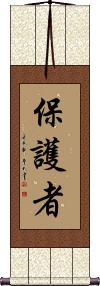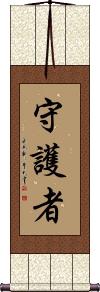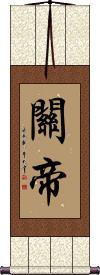Many custom options...
And formats...

Protector in Chinese / Japanese...
Buy a Protector calligraphy wall scroll here!
Personalize your custom “Protector” project by clicking the button next to your favorite “Protector” title below...
Protector
保護者 is the universal word for protector in Chinese, Japanese Kanji, and old Korean Hanja.
The first character means to defend, to protect, to insure or guarantee, to maintain, hold or keep, or to guard.
The second character means to protect.
Together the first and second characters create a word that means to defend, protect, or safeguard.
The last character means person.
Add all three characters together, and you have a word that means “protector,” one who will protect, guard, and keep you safe.
Some will also translate this word as guardian or patron.
Note: Not a common selection for a wall scroll in Asia.
See Also: Guardian Angel
Protector
守護者 is a Chinese, Japanese Kanji, and old Korean Hanja title for a protector, watcher, or keeper.
The character breakdown:
守護 = to guard; to protect; protection; safeguard.
者 = person; someone of that nature; someone doing that work, the one [who, which].
From this breakdown, you can translate this as “The one who protects,” “Someone who safeguards,” or “guardian.”
Guan Shi Yin: Protector Of Life
Guardian Angel
守護天使 is the title used for guardian angel in Chinese and Japanese Kanji.
It's used in the same way we use this title in the west - such as a guardian angel watching out for you and allowing you to survive a disaster or accident.
The first two characters mean to guard and protect. The second two mean “angel” (literally “Heaven's messenger”).
Guandi: God of War
These search terms might be related to Protector:
Alert / on Guard / Lingering Mind
Armor
Blessings and Protection
Divine Protection
Guard
Guardian / Defender
Guardian Angel
Hide / Shelter / Shield
Protect Guard Treasure Cherish
Protection
Shield
Under the Protection of the Dragon Saint
Not the results for Protector that you were looking for?
Below are some entries from our dictionary that may match your Protector search...
| Characters If shown, 2nd row is Simp. Chinese |
Pronunciation Romanization |
Simple Dictionary Definition |
關帝 关帝 see styles |
guān dì guan1 di4 kuan ti Kantei |
More info & calligraphy: Guandi: God of War |
保護者 保护者 see styles |
bǎo hù zhě bao3 hu4 zhe3 pao hu che hogosha ほごしゃ |
More info & calligraphy: Protectorguardian; protector; patron; parent |
觀世音 观世音 see styles |
guān shì yīn guan1 shi4 yin1 kuan shih yin Kanzeon かんぜおん |
More info & calligraphy: Guan Shi Yin: Protector Of Life(out-dated kanji) Avalokiteshvara (Bodhisattva); Avalokitesvara; Kannon; Kwannon; Guanyin; Buddhist deity of compassion Regarder of the world's sounds, or cries, the so-called Goddess of Mercy; also known as 觀音; 觀世音善薩; 觀自在 (觀世自在); 觀尹; 光世音 (the last being the older form). Avalokiteśvara, v. 阿 8. Originally represented as a male, the images are now generally those of a female figure. The meaning of the term is in doubt; it is intp. as above, but the term 觀自在 (觀世自在) accords with the idea of Sovereign Regarder and is not associated with sounds or cries. Guanyin is one of the triad of Amida, is represented on his left, and is also represented as crowned with Amida; but there are as many as thirty-three different forms of Guanyin, sometimes with a bird, a vase, a willow wand, a pearl, a 'thousand' eyes and hands, etc., and, when as bestower of children, carrying a child. The island of Putuo (Potala) is the chief centre of Guanyin worship, where she is the protector of all in distress, especially of those who go to sea. There are many sūtras, etc., devoted to the cult, but its provenance and the date of its introduction to China are still in doubt. Chapter 25 of the Lotus Sūtra is devoted to Guanyin, and is the principal scripture of the cult; its date is uncertain. Guanyin is sometimes confounded with Amitābha and Maitreya. She is said to be the daughter of king Śubhavyūha 妙莊王, who had her killed by 'stifling because the sword of the executioner broke without hurting her. Her spirit went to hell; but hell changed into paradise. Yama sent her back to life to save his hell, when she was miraculously transported on a Lotus flower to the island of Poo-too'. Eitel. |
桴 see styles |
fú fu2 fu bachi ばち ikada いかだ |
beam; rafter (1) plectrum; pick; (2) drumstick for Japanese drums (e.g. taiko); (1) (kana only) raft; (2) forearm protector; (3) skewered baby-eel kabayaki |
筏 see styles |
fá fa2 fa ikada いかだ |
raft (of logs) (1) (kana only) raft; (2) forearm protector; (3) skewered baby-eel kabayaki; (surname) Ikada A raft. |
鞆 see styles |
tomo とも |
archer's left-wrist protector; (given name) Tomoe |
地藏 see styles |
dì zàng di4 zang4 ti tsang jizou / jizo じぞう |
Kṣitigarbha, the Bodhisattva of the Great Vow (to save all souls before accepting Bodhi); also translated Earth Treasury, Earth Womb, or Earth Store Bodhisattva (surname) Jizou Ti-tsang, J. Jizō, Kṣitigarbha, 乞叉底蘗沙; Earth-store, Earth-treasury, or Earthwomb. One of the group of eight Dhvani- Bodhisattvas. With hints of a feminine origin, he is now the guardian of the earth. Though associated with Yama as overlord, and with the dead and the hells, his role is that of saviour. Depicted with the alarum staff with its six rings, he is accredited with power over the hells and is devoted to the saving of all creatures between the nirvana of Śākyamuni and the advent of Maitreya the fifth century he has been especially considered as the deliverer from the hells. His central place in China is at Chiu-hua-shan, forty li south-west of Ch'ing-yang in Anhui. In Japan he is also the protector of travellers by land and his image accordingly appears on the roads; bereaved parents put stones by his images to seek his aid in relieving the labours of their dead in the task of piling stones on the banks of the Buddhist Styx; he also helps women in labour. He is described as holding a place between the gods and men on the one hand and the hells on the other for saving all in distress; some say he is an incarnation of Yama. At dawn he sits immobile on the earth 地 and meditates on the myriads of its beings 藏. When represented as a monk, it may be through the influence of a Korean monk who is considered to be his incarnation, and who came to China in 653 and died in 728 at the age of 99 after residing at Chiu-hua-shan for seventy-five years: his body, not decaying, is said to have been gilded over and became an object of worship. Many have confused 眞羅 part of Korea with 暹羅 Siam. There are other developments of Ti-tsang, such as the 六地藏 Six Ti-tsang, i. e. severally converting or transforming those in the hells, pretas, animals, asuras, men, and the devas; these six Ti-tsang have different images and symbols. Ti-tsang has also six messengers 六使者: Yama for transforming those in hell; the pearl-holder for pretas; the strong one or animals; the devīof mercy for asuras; the devī of the treasure for human beings; one who has charge of the heavens for the devas. There is also the 延命地藏 Yanming Ti-tsang, who controls length of days and who is approached, as also may be P'u-hsien, for that Purpose; his two assistants are the Supervisors of good and evil 掌善 and 掌惡. Under another form, as 勝軍地藏 Ti-tsang is chiefly associated with the esoteric cult. The benefits derived from his worship are many, some say ten, others say twenty-eight. His vows are contained in the 地藏菩薩本願經. There is also the 大乘大集地藏十電經 tr. by Xuanzang in 10 juan in the seventh century, which probably influenced the spread of the Ti-tsang cult. |
大保 see styles |
daibo だいぼ |
(1) Grand Protector (lowest of the top three civil positions of the Zhou Dynasty); (2) Minister of the Right (official in Nara and Heian periods); (surname) Daibo |
太保 see styles |
tài bǎo tai4 bao3 t`ai pao tai pao taibao タイバオ |
a very high official in ancient China; juvenile delinquents (1) Grand Protector (lowest of the top three civil positions of the Zhou Dynasty); (2) Minister of the Right (official in Nara and Heian periods); (place-name) Taibao (Taiwan) |
帝俊 see styles |
dì jun di4 jun4 ti chün |
Dijun, Shang dynasty protector God, possibly same as legendary Emperor 帝嚳|帝喾[Di4 Ku4] |
月支 see styles |
yuè zhī yue4 zhi1 yüeh chih Gasshi げっし |
the Yuezhi, an ancient people of central Asia during the Han dynasty (also written 月氏[Yue4 zhi1]) Yuezhi; Rouzhi; an ancient Central Asian people (月支國) The Yuezhi, or 'Indo-Scythians', 月氏 (國) and a country they at one time occupied, i. e. 都貨羅 Tukhara, Tokharestan, or Badakshan. Driven out from the northern curve of the Yellow River by the Huns, circa 165 B. C., they conquered Bactria 大夏, the Punjab, Kashmir, 'and the greater part of India. ' Their expulsion from the north of Shansi was the cause of the famous journey of Zhangqian of the Han dynasty and the beginning of Chinese expansion to the north-west. Kanishka, king of the Yuezhi towards the end of the first century A. D., became the great protector and propagator of Buddhism. |
水天 see styles |
shuǐ tiān shui3 tian1 shui t`ien shui tien suiten すいてん |
(1) water and sky; (2) Varuna; Vedic god of water and sky (adopted into Buddhism as god of water and protector of the west) Varuṇa, 縛嚕拏; 婆樓那 ούϕανός, the heavens, or the sky, where are clouds and dragons; the 水神 water-deva, or dragon-king, who rules the clouds, rains, and water generally. One of the 大神 in the esoteric maṇḍalas; he rules the west; his consort is the 水天妃 represented on his left, and his chief retainer 水天眷屬 is placed on his right. |
胸当 see styles |
muneate むねあて munaate / munate むなあて |
(irregular okurigana usage) (1) breastplate; chest protector; (2) bib |
衆祐 众祐 see styles |
zhòng yòu zhong4 you4 chung yu shuyū |
Protector or Benefactor of all, an old intp. of Bhagavat. |
護法 护法 see styles |
hù fǎ hu4 fa3 hu fa gohou / goho ごほう |
to keep the law; to protect Buddha's teachings; protector of Buddhist law (i.e. temple donor) (1) {Buddh} defence of Buddhist doctrines; god who defends Buddhist doctrines; (2) defence of the constitution; (3) religious power to dispel demons and diseases; (surname) Gohou To protect or maintain the Buddha-truth; also name of Dharmapāla q.v. |
賴吒 赖咤 see styles |
lài zhà lai4 zha4 lai cha raita |
(賴吒啝羅) rāṣṭrapāla, protector of a kingdom, king. |
都護 都护 see styles |
dū hù du1 hu4 tu hu togo とご |
(old) highest administrative post in border areas; governor of a march (1) (hist) (See 都護府) Protector General (Tang-period Chinese official); (2) (hist) (See 按察使) travelling inspector of the provincial governments (Nara and Heian-period position) |
醜目 丑目 see styles |
chǒu mù chou3 mu4 ch`ou mu chou mu Shūmoku |
醜眼 Virūpākṣa; ugly-eyed, i.e. Śiva with his three eyes; also the name of the mahārāja-protector of the West, v. 毘. |
防具 see styles |
bougu / bogu ぼうぐ |
guard; protector; defensive armament; personal armor (armour) |
五部淨 五部净 see styles |
wǔ bù jìng wu3 bu4 jing4 wu pu ching gobu jō |
(居 炎 摩 羅) Yama as protector in the retinue of the thousand-hand Guanyin. |
大威德 see styles |
dà wēi dé da4 wei1 de2 ta wei te dai itoku |
Mahātejas. Of awe-inspiring power, or virtue, able to suppress evildoers and protect the good. A king of garuḍas, v. 迦. Title of a 明王 protector of Buddhism styled 大威德者; 大威德尊; 大威德明王; 百光扁照王; there are symbols, spells, esoteric words, sutras, etc., connected with this title. |
守護人 see styles |
shugonin しゅごにん |
(archaism) guard; protector |
守護神 守护神 see styles |
shǒu hù shén shou3 hu4 shen2 shou hu shen shugojin; shugoshin しゅごじん; しゅごしん |
protector God; patron saint guardian deity |
庇護者 see styles |
higosha ひごしゃ |
guardian; mentor; protector |
弼馬温 see styles |
hitsubaon ひつばおん |
(char) Protector of the Stables (title given to the Monkey King in the novel "Journey to the West" when he is given a job in Heaven); (ch) Protector of the Stables (title given to Son Goku in the novel "Saiyūki" when he is given a job in Heaven) |
持法者 see styles |
chí fǎ zhě chi2 fa3 zhe3 ch`ih fa che chih fa che jihōsha |
A keeper or protector of the Buddha-law. |
擋風牆 挡风墙 see styles |
dǎng fēng qiáng dang3 feng1 qiang2 tang feng ch`iang tang feng chiang |
lit. windbreak; fig. protector |
焔摩天 see styles |
enmaten えんまてん |
(Buddhist term) Yama (as protector deity of the south in esoteric Buddhism) |
Variations: |
ikada; ikada いかだ; イカダ |
(1) (kana only) raft; (2) forearm protector; (3) (See かば焼き) skewered baby-eel kabayaki |
胸あて see styles |
muneate むねあて munaate / munate むなあて |
(1) breastplate; chest protector; (2) bib |
Click here for more Protector results from our dictionary
The following table may be helpful for those studying Chinese or Japanese...
| Title | Characters | Romaji (Romanized Japanese) | Various forms of Romanized Chinese | |
| Protector | 保護者 保护者 | hogosha | bǎo hù zhě bao3 hu4 zhe3 bao hu zhe baohuzhe | pao hu che paohuche |
| Protector | 守護者 守护者 | shu go sha / shugosha | shǒu hù zhě shou3 hu4 zhe3 shou hu zhe shouhuzhe | shou hu che shouhuche |
| Guan Shi Yin: Protector Of Life | 觀世音 观世音 | kanzeon | guān shì yīn guan1 shi4 yin1 guan shi yin guanshiyin | kuan shih yin kuanshihyin |
| Guardian Angel | 守護天使 守护天使 | shu go ten shi shugotenshi | shǒu hù tiān shǐ shou3 hu4 tian1 shi3 shou hu tian shi shouhutianshi | shou hu t`ien shih shouhutienshih shou hu tien shih |
| Guandi: God of War | 關帝 关帝 | kan tei / kantei | Guān dì / Guan1 di4 / Guan di / Guandi | Kuan ti / Kuanti |
| In some entries above you will see that characters have different versions above and below a line. In these cases, the characters above the line are Traditional Chinese, while the ones below are Simplified Chinese. | ||||
Successful Chinese Character and Japanese Kanji calligraphy searches within the last few hours...








